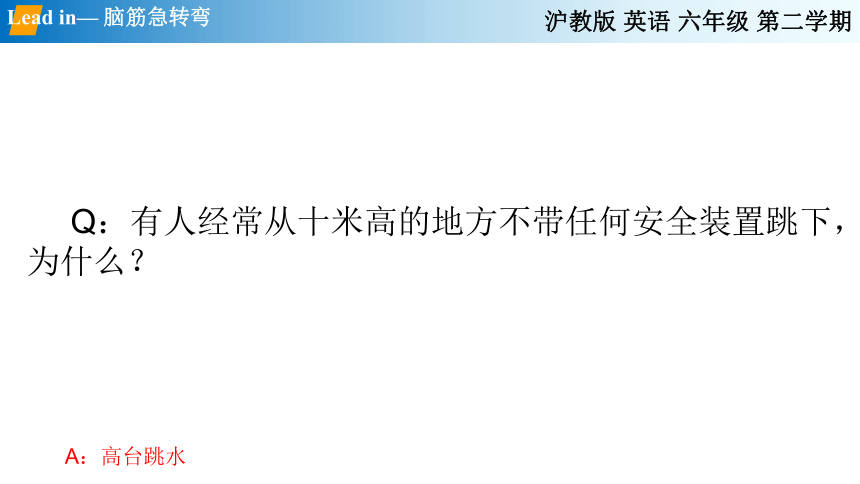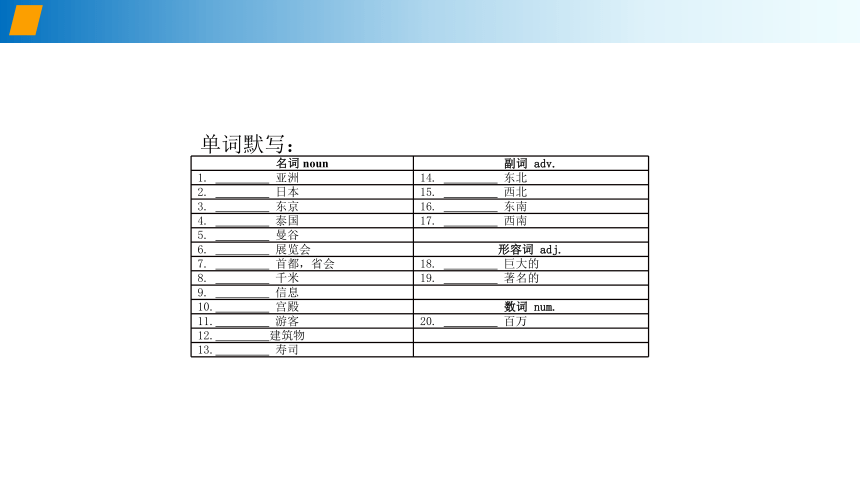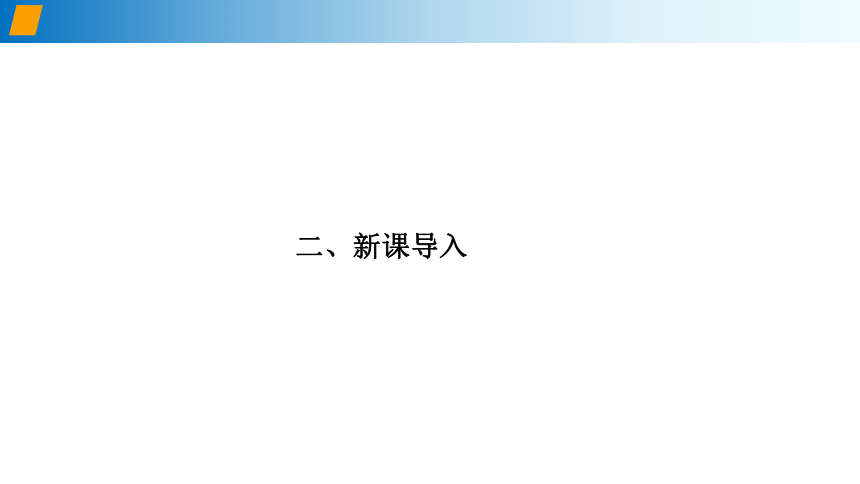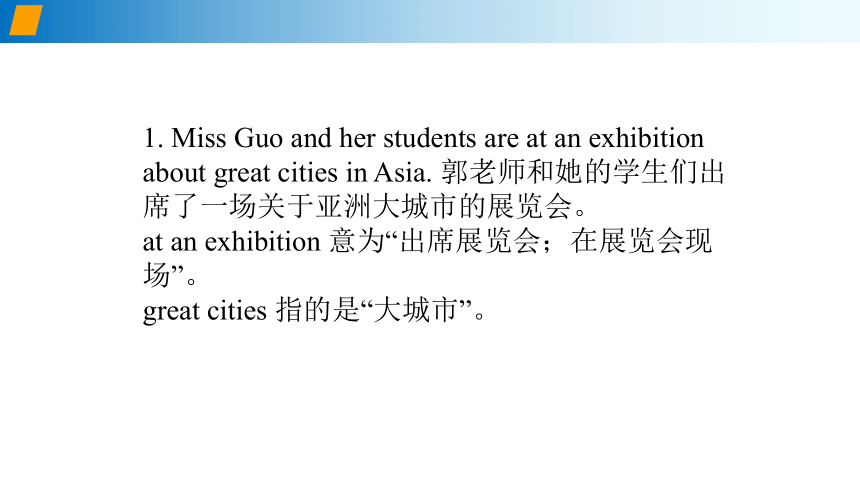Unit 1 Great cities in Asia 第2课时 语法知识及拓展(课件)-2021-2022学年六年级英语下册同步备课系列(牛津上海版)
文档属性
| 名称 | Unit 1 Great cities in Asia 第2课时 语法知识及拓展(课件)-2021-2022学年六年级英语下册同步备课系列(牛津上海版) |  | |
| 格式 | pptx | ||
| 文件大小 | 451.7KB | ||
| 资源类型 | 试卷 | ||
| 版本资源 | 牛津上海版(试用本) | ||
| 科目 | 英语 | ||
| 更新时间 | 2022-02-17 17:27:31 | ||
图片预览









文档简介
(共25张PPT)
Lead in— 脑筋急转弯
Q:有人经常从十米高的地方不带任何安全装置跳下,为什么?
A:高台跳水
沪教版 英语 六年级 第二学期
Snow and Ice Knowledge 冰雪知识
Ski jumping
一、课前回顾
单词默写:
名词 noun 副词 adv.
1. 亚洲 14. 东北
2. 日本 15. 西北
3. 东京 16. 东南
4. 泰国 17. 西南
5. 曼谷
6. 展览会 形容词 adj.
7. 首都,省会 18. 巨大的
8. 千米 19. 著名的
9. 信息
10. 宫殿 数词 num.
11. 游客 20. 百万
12. 建筑物
13. 寿司
二、新课导入
【思考】
介词 in, on, to的用法?
三、新课讲解
1. Miss Guo and her students are at an exhibition about great cities in Asia. 郭老师和她的学生们出席了一场关于亚洲大城市的展览会。
at an exhibition 意为“出席展览会;在展览会现场”。
great cities 指的是“大城市”。
2. Beijing is the capital of China. 北京是中国的首都。
the capital of 意为“……的首都”
3. Which city is the capital of Japan 日本的首都是哪座城市?
用which 引导的特殊疑问句来询问具体的事物,通常后接名词或代词。
4. It’s north-east of Shanghai.它位于上海的东北方。
north-east of 表示“在……东北方”,指的是不相邻且没有包含关系的两个独立事物间的位置关系,也可以说成 to the north-east of
5. How far is it from Shanghai to Beijing 北京距离上海有多远?
How far … 意为“距离(多远)”,用How far 引导的特殊疑问句来询问距离的远近。
不定代词 it 在这里指代“距离”
介词结构 from … to … 表示“从……到……”
6. ----How long does it take to travel from Shanghai to Beijing by train 乘火车从上海到北京要多久?
---- It takes about ten hours. 大约10 小时。
How long 表示“多久”,用于对一段时间的提问。
这里take 意为“花费”。it 在这里是形式主语,真正的主语是后面的动词不定式 to do sth.
It takes sb. some time to do sth. 表示做某事花费某人多少时间
7. 3.5 hours
three hours and a half / three and a half hours
1.5 hours
one and a half hours/ an hour and a half
8. In the past, people travelled to other places by ship. Today, people usually travel to other places by plane or by train.
过去,人们乘船去别的地方。如今,人们通常都坐飞机或火车去别的地方。
in the past 在过去,通常做时间状语,句中的时态用一般过去时。
travel to 去某地
by ship=by sea by plane=by air
9. Many tourists like visiting those places. 许多游客喜欢游览那些地方。
like / love / enjoy doing sth . 喜欢做某事
10. There are more than 19 million people in Shanghai.
more than 超过,多于, 与over近意
11. They also love eating spicy food. 他们还喜欢吃辣的食物。
also, too, either, else 都有“也,还”的意思。
too 和 also 直用于肯定句,其中too用在句末,also用在句中的行为动词之前、系动词之后。either 用于否定句的句末。else 用于疑问词或不定代词之后。
e.g. I’ m a student, too.
I’ m also a student.
He isn’t a student, either.
What else do you usually do with your mother
Is there anyone else in
12.乘坐交通工具的表达
(1)可以用by的介词词组来表达,但步行一定要用on foot表示。
e. g. I go to school by bus/by underground.我乘公共汽车/地铁上学。
He goes to school on foot.他步行上学。
(2)乘飞机可以用by plane也可以用by air;乘船可以用by ship /boat,也可以用by sea(但不能用by lake或by river)。
(3)如指具体某一辆车或船可以用on或in的介词词组来表示。
e. g. He often goes to Beijing on the train.他通常乘这班火车去北京。
She goes to work in her car.她开她的汽车上班。
【友情提示】这种用法需要有定冠词或物主代词,且空间较小的如汽车通常用in,其他空间较大的交通工具一般用on。
(1)Are there more _________ 15 million people in Beijing now
A. much B. about C. than D. less
(2)Can you tell me ________ city is the capital of the USA
A. what B. which C. where D. how
(3)Traveling __________ air is much faster than traveling ________ sea.
A. from, to B. by, at C. in, at D. by, by
(4)Today, more and more people like traveling to ____________ places by plane. It’s faster and more comfortable.
A. other B. others C. the other D. to playing
(5)How far is it _________ Shanghai _________ Singapore
A. to, from B./, to C. from, / D. from, to
(6)Tina, have you finished your homework _____________
A. just B. only C. yet D. already
随堂练习
(7)Would you like __________ a cup of coffee
A. have B. having C. to D. to have
(8)My aunt left ______________ Australia to have a trip last Sunday.
A. for B. in C. to D. at
(9)------__________ will Tommy stay with his aunt and uncle in Florida
------For two months.
A. How B. How many C. How far D. How long
(10)We will have a picnic tomorrow. Have you bought __________ food, Grace
A. enough B. many C. a lot D. several
(11)My aunt was born forty years ___________ in Tokyo.
A. after B. later C. before D. ago
(12)The new king didn’t ___________ Qu Yuan’s advice, so he lost the battle.
A. listened to B. listen to C. hear D. heard
(13)Who is good ______ writing and drawing in your class
A. on B. at C. in D. to
1-5 CBDAD 6-10 CDADA 11-13 DBB
四、课堂小结
愿君皆有所获,皆有所得
Lead in— 脑筋急转弯
Q:有人经常从十米高的地方不带任何安全装置跳下,为什么?
A:高台跳水
沪教版 英语 六年级 第二学期
Snow and Ice Knowledge 冰雪知识
Ski jumping
一、课前回顾
单词默写:
名词 noun 副词 adv.
1. 亚洲 14. 东北
2. 日本 15. 西北
3. 东京 16. 东南
4. 泰国 17. 西南
5. 曼谷
6. 展览会 形容词 adj.
7. 首都,省会 18. 巨大的
8. 千米 19. 著名的
9. 信息
10. 宫殿 数词 num.
11. 游客 20. 百万
12. 建筑物
13. 寿司
二、新课导入
【思考】
介词 in, on, to的用法?
三、新课讲解
1. Miss Guo and her students are at an exhibition about great cities in Asia. 郭老师和她的学生们出席了一场关于亚洲大城市的展览会。
at an exhibition 意为“出席展览会;在展览会现场”。
great cities 指的是“大城市”。
2. Beijing is the capital of China. 北京是中国的首都。
the capital of 意为“……的首都”
3. Which city is the capital of Japan 日本的首都是哪座城市?
用which 引导的特殊疑问句来询问具体的事物,通常后接名词或代词。
4. It’s north-east of Shanghai.它位于上海的东北方。
north-east of 表示“在……东北方”,指的是不相邻且没有包含关系的两个独立事物间的位置关系,也可以说成 to the north-east of
5. How far is it from Shanghai to Beijing 北京距离上海有多远?
How far … 意为“距离(多远)”,用How far 引导的特殊疑问句来询问距离的远近。
不定代词 it 在这里指代“距离”
介词结构 from … to … 表示“从……到……”
6. ----How long does it take to travel from Shanghai to Beijing by train 乘火车从上海到北京要多久?
---- It takes about ten hours. 大约10 小时。
How long 表示“多久”,用于对一段时间的提问。
这里take 意为“花费”。it 在这里是形式主语,真正的主语是后面的动词不定式 to do sth.
It takes sb. some time to do sth. 表示做某事花费某人多少时间
7. 3.5 hours
three hours and a half / three and a half hours
1.5 hours
one and a half hours/ an hour and a half
8. In the past, people travelled to other places by ship. Today, people usually travel to other places by plane or by train.
过去,人们乘船去别的地方。如今,人们通常都坐飞机或火车去别的地方。
in the past 在过去,通常做时间状语,句中的时态用一般过去时。
travel to 去某地
by ship=by sea by plane=by air
9. Many tourists like visiting those places. 许多游客喜欢游览那些地方。
like / love / enjoy doing sth . 喜欢做某事
10. There are more than 19 million people in Shanghai.
more than 超过,多于, 与over近意
11. They also love eating spicy food. 他们还喜欢吃辣的食物。
also, too, either, else 都有“也,还”的意思。
too 和 also 直用于肯定句,其中too用在句末,also用在句中的行为动词之前、系动词之后。either 用于否定句的句末。else 用于疑问词或不定代词之后。
e.g. I’ m a student, too.
I’ m also a student.
He isn’t a student, either.
What else do you usually do with your mother
Is there anyone else in
12.乘坐交通工具的表达
(1)可以用by的介词词组来表达,但步行一定要用on foot表示。
e. g. I go to school by bus/by underground.我乘公共汽车/地铁上学。
He goes to school on foot.他步行上学。
(2)乘飞机可以用by plane也可以用by air;乘船可以用by ship /boat,也可以用by sea(但不能用by lake或by river)。
(3)如指具体某一辆车或船可以用on或in的介词词组来表示。
e. g. He often goes to Beijing on the train.他通常乘这班火车去北京。
She goes to work in her car.她开她的汽车上班。
【友情提示】这种用法需要有定冠词或物主代词,且空间较小的如汽车通常用in,其他空间较大的交通工具一般用on。
(1)Are there more _________ 15 million people in Beijing now
A. much B. about C. than D. less
(2)Can you tell me ________ city is the capital of the USA
A. what B. which C. where D. how
(3)Traveling __________ air is much faster than traveling ________ sea.
A. from, to B. by, at C. in, at D. by, by
(4)Today, more and more people like traveling to ____________ places by plane. It’s faster and more comfortable.
A. other B. others C. the other D. to playing
(5)How far is it _________ Shanghai _________ Singapore
A. to, from B./, to C. from, / D. from, to
(6)Tina, have you finished your homework _____________
A. just B. only C. yet D. already
随堂练习
(7)Would you like __________ a cup of coffee
A. have B. having C. to D. to have
(8)My aunt left ______________ Australia to have a trip last Sunday.
A. for B. in C. to D. at
(9)------__________ will Tommy stay with his aunt and uncle in Florida
------For two months.
A. How B. How many C. How far D. How long
(10)We will have a picnic tomorrow. Have you bought __________ food, Grace
A. enough B. many C. a lot D. several
(11)My aunt was born forty years ___________ in Tokyo.
A. after B. later C. before D. ago
(12)The new king didn’t ___________ Qu Yuan’s advice, so he lost the battle.
A. listened to B. listen to C. hear D. heard
(13)Who is good ______ writing and drawing in your class
A. on B. at C. in D. to
1-5 CBDAD 6-10 CDADA 11-13 DBB
四、课堂小结
愿君皆有所获,皆有所得
同课章节目录
- Module 1 City life
- Unit 1 Great cities in Asia
- Unit 2 At the airport
- Unit 3 Dragon Boat Festival
- Unit 4 Staying healthy
- Module 2 Changes
- Unit 5 What will I be like?
- Unit 6 Seasonal changes
- Unit 7 Travelling in Garden City
- Module 3 The nature world
- Unit 8 Windy weathe
- Unit 9 Sea water and rain wate
- Unit 10 Forests and land
- Unit 11 Controlling fire
